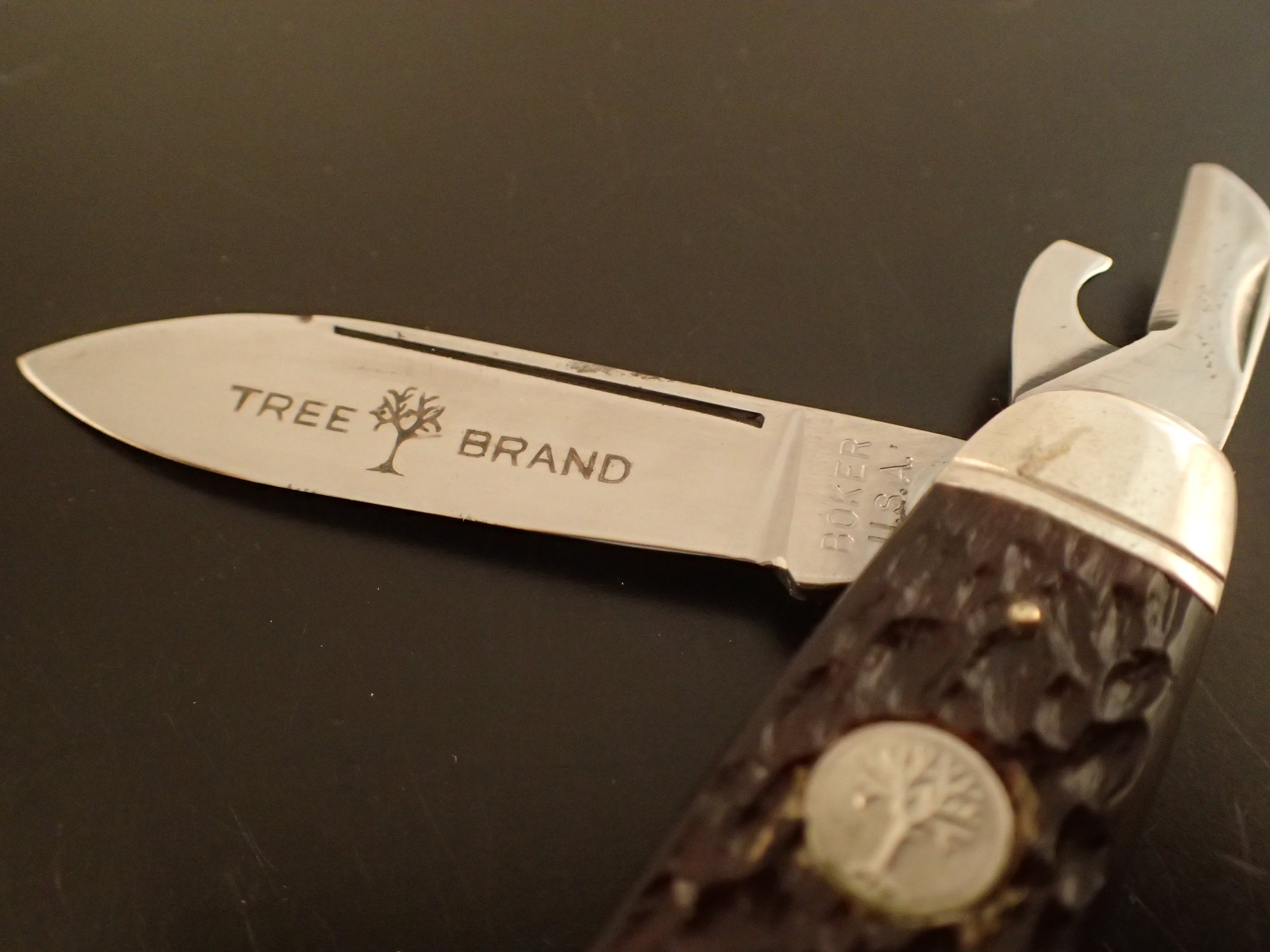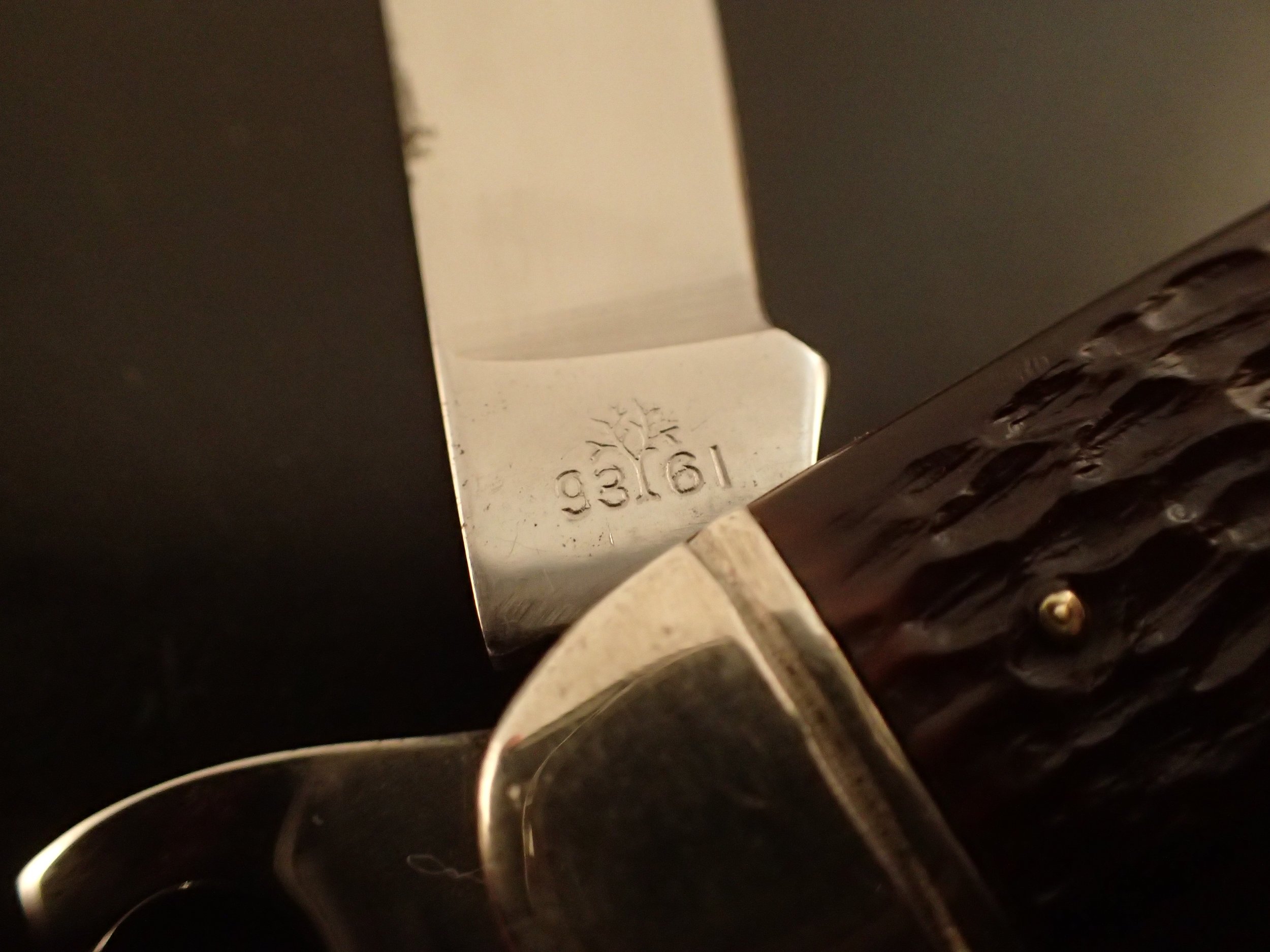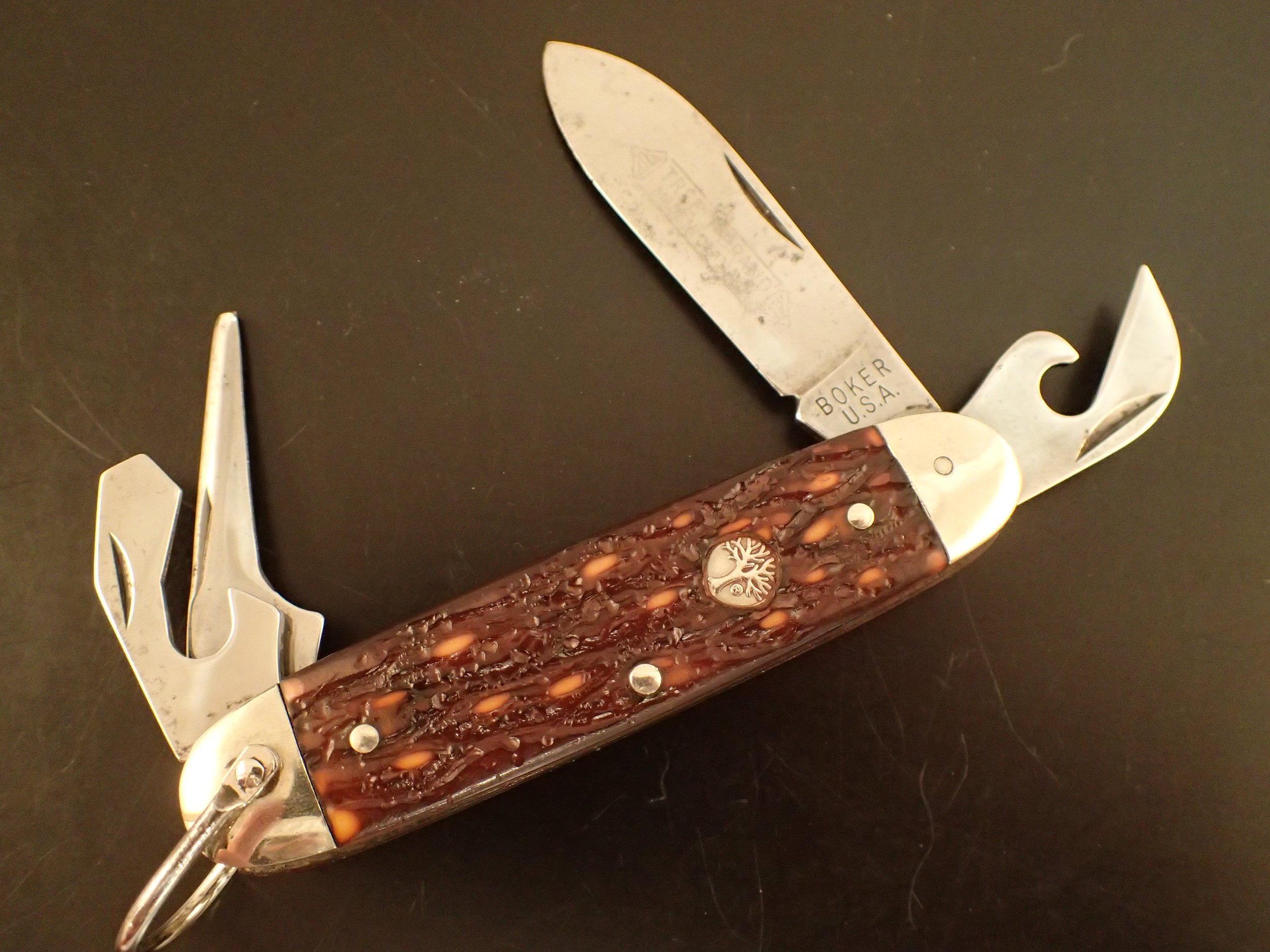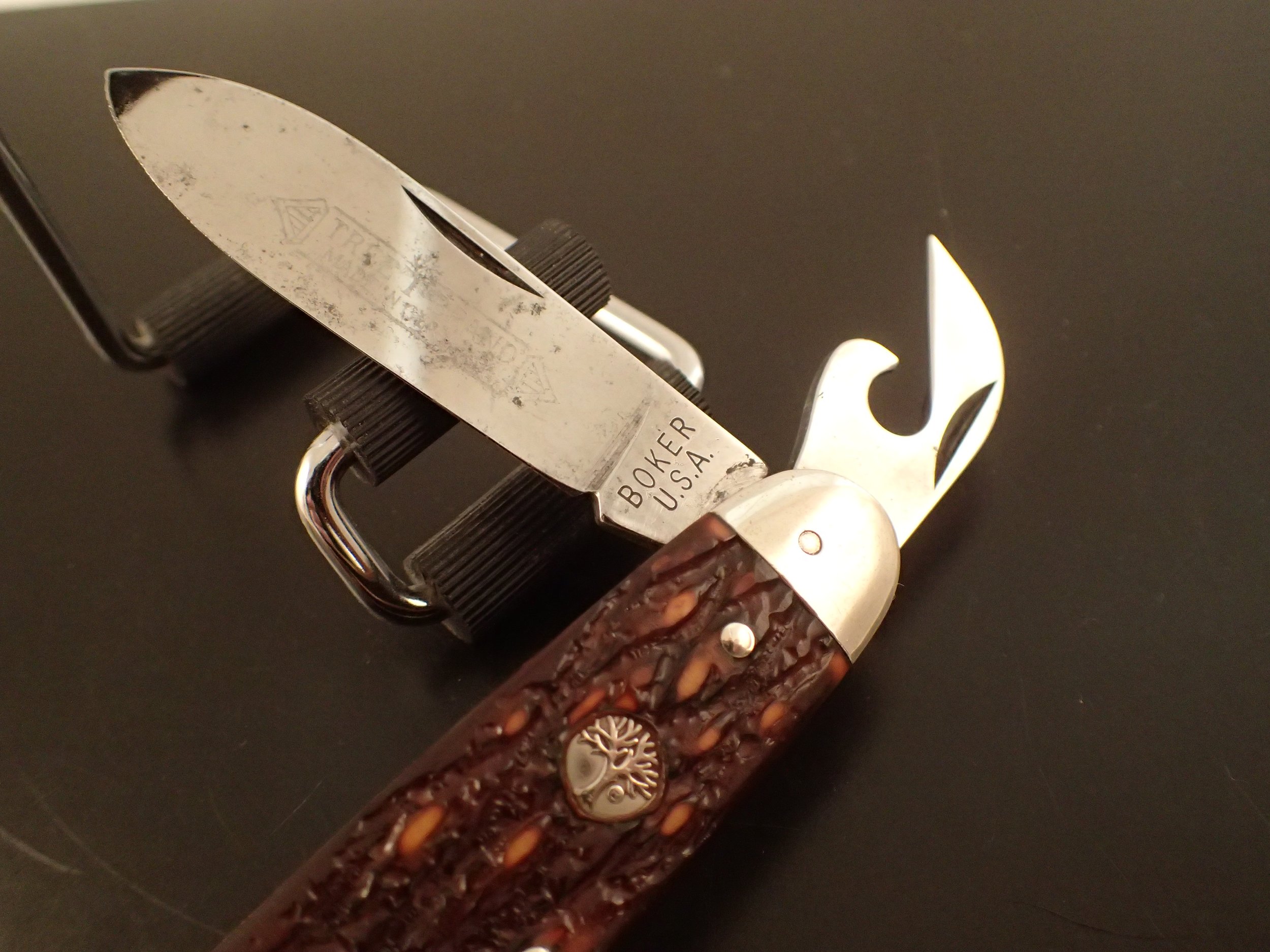Through the Decades: Collecting the Boker 9361 Scout/Utility Knife, Part 2.
Myron Erickson
Welcome to Part 2 of my two-part article on the Boker 9361, a classic four-blade American-made scout/utility knife. Part 1 covered the origins of the 9361 in the 1920’s and takes the reader through the Golden Age of this pocket knife when design, materials, and workmanship peaked in the mid-1960’s or thereabouts. We left off with the ca. 1960 tool set updates — an improved, two-piece can opener and, for the first time, a pen blade.
It’s good to have a user/carrier.
1965-1970, the New Britain Machine Era.
Boker USA was bought by the New Britain Machine Company in 1965, joining well respected tool brands Husky and Blackhawk. The Golden Age of the 9361 was coming to a close, at least in this author’s opinion (and only in retrospect), but these are still very solid, well-made knives worthy of your time and attention.
Still the Golden Age, a 9361 from the New Britain era.
Construction. 9361’s from this era feature brass liners, spacer, and pins. The lined bolsters and bail are of nickel-silver. Jigged bone scales are gradually being replaced by a jigged Delrin product, marketed as “Improved Stag,” which are as thin and finely worked as the real bone materials they replaced. The distinction becomes more apparent with more pocket wear, but in original condition it can be very tricky to tell the difference. I’ve seen many, many auction descriptions that claim a Delrin knife to be of jigged bone, while an older jigged bone knife is often said to be Delrin.
Tool set. The tools are unchanged from the last generation of 9361. If you liked the pen blade then, you’ll like it now. The two-piece safety style can opener and long screwdriver are here, as is the main blade’s long pull and artful swedge.
Shield, Tang, and Etch. Notably, the banner shield is gone and the round Tree shield returns, without any other markings on it, making it immediately familiar to Böker 182 collectors. The BOKER USA tang stamp, at least, is a little more professionally applied to the obverse tang, and on the reverse tang the model number 9361 is bisected with the Tree logo, a nod to Boker’s heritage. The blade etch is a light TREE BRAND, also bisected by the Tree.
A Mystery Knife. I have a peculiar 9361 that I think comes from this period, which uses a moderately sized lobster claw can opener with a definite Camillus look to it. Again, we see the cross pollination/cooperation of these two brands. The construction details of this knife are the same, on paper at least, to the 9361 of this time: brass liners, spacer, and pins; nickel-silver lined bolsters and bail. Tang stamps are the same, and there are no changes to the pen blade or cap lifter.
A mystery 9361. Note the very Camillus-like can opener.
But the main blade has lost its long nail pull and lacks any swedge. The frame is a full millimeter narrower as measured at the center pin, and the back scale has a carefully made cut-out allowing easier access to the pen blade’s nail nick. The head on the center pin is also noticeably smaller than on any other 9361 before or after it, and the scales appear to be a high quality composite material, not Improved Stag. Comparing this knife to others in my collection I realized that it is a clone of the Ka-Bar 1152 from roughly this same period of time. I wouldn’t be surprised if both knives were made by Camillus, though, so if you know, please get in touch.
Another Mystery Knife. Made available as a less expensive retail alternative, and perhaps also produced in fulfillment of a government procurement contract, the engineer’s knife made during this time also employed the ca. 1960 tool layout upgrade. And in contrast to its war-time engineer’s predecessor, it also enjoyed brass scales, liner, and pins, but bolsters and bail remained of iron. Perhaps the most noticeably different element is the ugly, black, molded nylon scales (not actually jigged, and not even Delrin). It uses the two-piece, straight shear edge can opener, but in a sign of things to come, the main blade loses its robust long nail pull and reverts to the simple crescent nail nick, although it is still swedged on both sides. The model number 9361 is absent from the reverse tang.
Gov’t contract? Cheapie department store special?
Although rather ugly and devoid of the Golden Age 9361’s charms, if you just want a vintage Boker scout knife and don’t care about aesthetics, these can still be had in like-new condition for $25. Well used specimens go for even less. Notably, you will see this exact same knife with Camillus tang stamps, another reason to wonder about the relationship between these two companies and perhaps the state of the industry itself during this time.
The Boker Black Beauty has the ca. 1960 can opener, but no 9361 tang stamp.
1970-’76, the Wiss Era.
In 1970, H. Boker & Co. was acquired by J. Wiss & Sons, the famous American scissors manufacturer, and for a few years the 9361 was available as a Wiss product. My specimen from this era is actually a John Primble branded knife.
Construction and Tool Set. The Wiss knife keeps the familiar 9361 formula, but does away with the two-piece straight shear edge can opener, replacing it with a comically large, one-piece lobster claw style. The main blade has a different grind to it as well, right where the spine of the blade meets the tang or ricasso. It’s subtle and easily missed on first inspection. A straight nail pull reappears, albeit not as long as the original, but still. The Improved Stag jigged Delrin scales continue to trick the unwary, and we finally bid adieu to the thoughtful threading on the nickel-silver bolsters.
The Wiss era knives had lost the lined bolsters and included a super jumbo can opener.
Shield, Tang, and Etch. At first glance the round shield appears to be the Boker Tree, but a second look reveals that it is actually the Wiss Eagle. BOKER USA does not appear on the mark side tang, and the main blade displays a WISS blade etch. I don’t own one of these knives but would like to, so if you have one you wouldn’t mind parting with, please get in touch. :)
1976-’83, the Cooper Group Era.
The Wiss era lasted until 1976, when Wiss was acquired by the Cooper Group, which now added Wiss and Boker to such famous tool brands as Crescent, Lufkin, and Nicholson. Notably, production was moved from Maplewood, New Jersey, where Boker knives had been made since 1921, to Statesboro, Georgia, in 1978, a city known more for cotton agriculture and a famous song covered by the Allman Brothers than for knife making. Sadly, this lack of legacy shows in the quality of Boker products from this time.
A user/carrier from the Cooper Group era.
Construction and Tool Set. Under Cooper Group’s ownership, the 9361 keeps its brass liners and spacer, while the pins appear to be of a steel alloy or maybe nickel-silver. Bozo the Clown’s favorite can opener remains, as does the mid-length straight nail pull. But tempering your excitement over the straight pull is the brutal squareness of the blade edges; not even vestigial amounts of swedge or finishing are present. These blades seem to have more in common with tools made for yard work than fine cutlery. The back springs have a weak action, producing a snap that can best be described as relaxed when new, and becoming downright anemic with age.
This time capsule knife came out of its blister pack with brown goo on the bolster.
Shield, Tang, and Etch. The round Tree shield returns, and this time it includes the words TREE BRAND below the tree. The tang is stamped BOKER USA on the obverse, and 9361, bisected by a Tree logo, is present again on the reverse tang. The blade is lightly etched similarly.
Note the sharp angle where the back side meets curved part of the bolster.
Freedom! I have two of these knives. One appears almost unused but its steel is very darkly stained, and the other I bought as new old stock, still in its ca. 1982 blister pack. I polled the members of my local pocket knife club as to wether or not I should be the one to free it from its packaging, and unanimously the group said no, acting on their collector instinct, I guess. I kept it for a while like this, but finally decided that 40+ years of being stored with all four implements half-open and the springs at maximum deflection on both ends was enough. And you know what? After freeing it from its cardboard and plastic prison, the spring on the blade layer is almost completely dead.
Don’t store your knives like this! The Cooper Group era 9361, still in its 40+ year old packaging.
Even overlooking this, examining the knife closely reveals just how far quality had slipped during the made-in-Georgia era. Crudely crafted implements, indifferent assembly, and downright shoddy final finishing are all glaringly apparent. You will see these knives with irregular finishing on the backside, right where it meets the curvature of the bolstered end. Do not assume this was done by an overzealous previous owner experimenting with the new buffer wheel he got for Christmas. Again, this would seem to be what happens when you assume that the skills required for manufacturing grass trimming shears are the same as those needed by fine cutlers.
Little wonder, then, that Boker USA could not compete with the likes of high quality makers Victorinox and Case at the time, and closed its doors in 1983. But, there was one more chapter to come for the 9316, and the story ends on a good note.
ca.1986 — ca.1988, the Böker 9361.
After Boker USA ceased production in the US in 1983, Solingen Böker negotiated with the Cooper Group for the Boker USA name and trademarks, something collectors today should be thankful for. As a part of this transition, significant stocks of unassembled knife parts remaining in Georgia were sent to Solingen for finishing and assembly. Although blade tangs had already been stamped BOKER USA, a TREE BRAND / MADE IN GERMANY etch was added, resulting in double-marked knives. My example from this period uses the super-ugly (sorry, my opinion) “tree bark” Delrin scales, but at least the one-piece can opener has lost its gargantuan dimensions, and, great news, the awl returns.
The “tree bark” 9361. Made in the USA, assembled in Solingen.
The round tree shield on the front scale now appears with a circle-R trademark symbol. The liners and spacer are brass, and the bolsters (again, unlined) and pins are nickel-silver; oddly perhaps, the bail on mine appears to be steel. The obverse tang is stamped BOKER USA, and the reverse is stamped 9361 with no bisecting Tree logo. The blades are nicely polished and the can opener and cap lifter are different than any we’ve seen before (note also that they are different than those on the contemporaneous Böker 182). The spring action is strong and the snap convincing.
Although a bit homely because of the scales, the last 9316 is a real pocket knife, assembled and finished by real cutlers and craftspersons in Germany, a fitting end to its 60+ year run.
Postscript.
The modern descendant of the 9361 is the Böker Magnum Classic Pocket Steel. My friend and fellow 9361 fan, Matt, sent me one right from a knife dealer with a note that said, “For research purposes.” The name seems a bit long-winded, but, regardless, the knife has pretty rosewood scales and 440A stainless steel blades. Presumably the springs, liners, pins, and bail are also stainless steel. I have to say the knife has decent action, although nothing remotely like my 1920’s “Boy Scout” knife with its finger-guillotine snap. The can opener is a moderately sized one-piece mounted on the knife end, and the awl is a hybrid pen blade/punch style. The back of the knife is very smoothly and uniformly finished off, more nicely, in fact, than the Cooper Group specimens in my collection.
Overall, it’s a great value for $24 (and is available for less from dealers), but it has a couple of issues. The pin heads and the crimped ends of the bail wire are sharp and jagged, and one of the rosewood scales is trimmed about 1/32” too short. I wish the top scale had a shield of some sort, and I don’t like the way the back shoulders of the tools stick up above the profile of the knife body, like a Camillus 1760. But otherwise, and especially considering the price, it’s quite amazing. If I were just starting out, I have to say I’d probably save my pennies until I got to $48 and could order a brand new Victorinox Pioneer, but that’s just me. The Böker is a great knife at an amazing price.
You don’t get what you don’t pay for.
And I’m spent…
This post turned into a bigger project than I had imagined it would, mostly because I kept discovering new variations, nuances, and exceptions to the rule the more I looked into the Boker 9361. I am sure there are other mystery knives to be discovered, and I wouldn’t be surprised if I got a detail or two wrong with the evolution of this model. I always welcome any factual corrections, and hope other collectors will chime in with their comments. Thank you for reading.



















